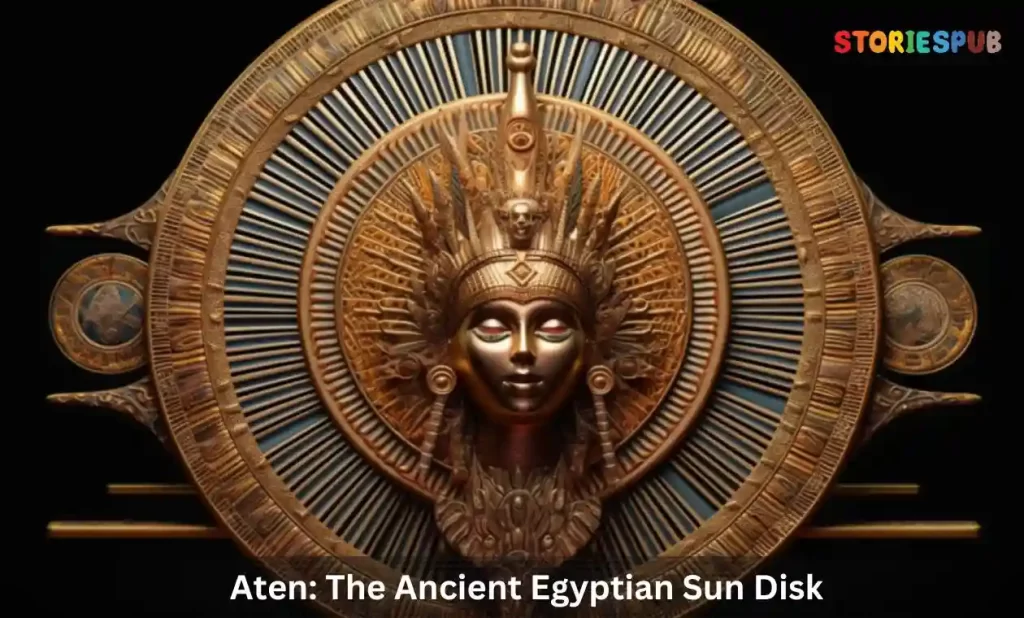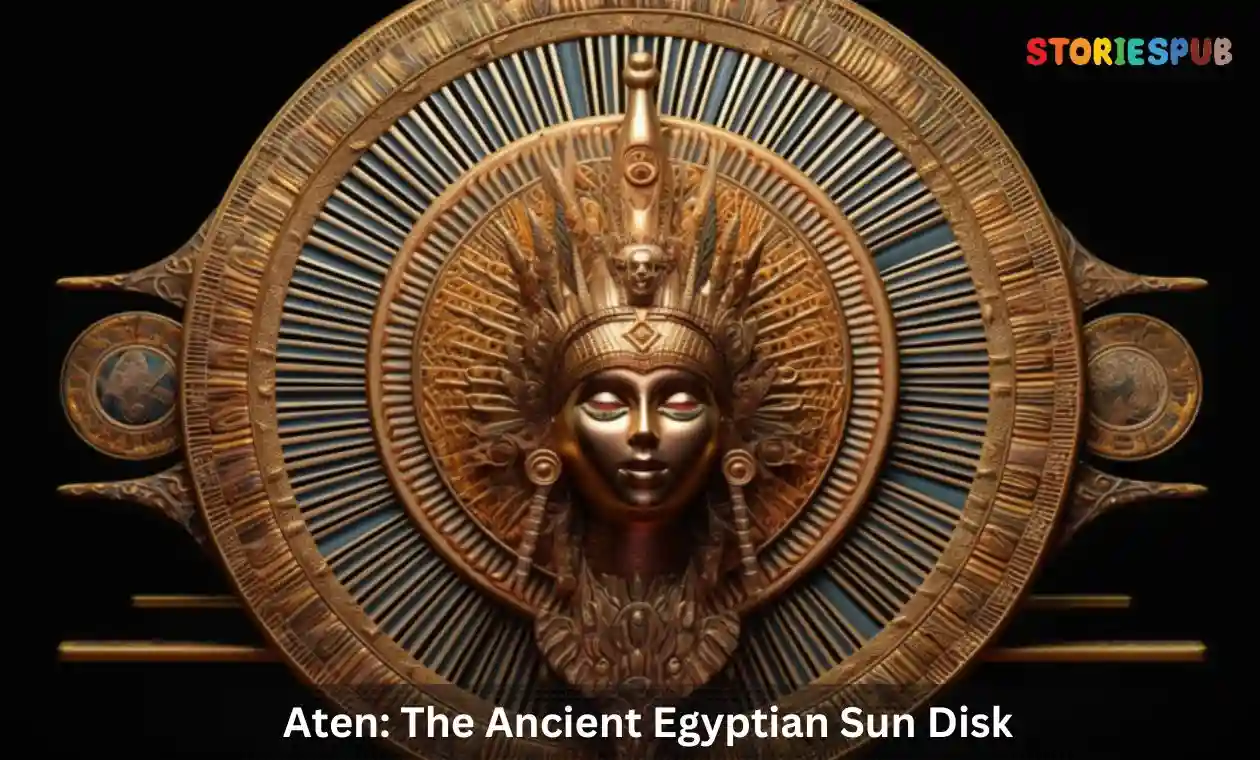Aten: The Solar Deity’s Powerful Reign

Introduction:
Ancient Egypt is known for its impressive architecture, advanced mathematics, and intricate hieroglyphs. However, one of the most intriguing aspects of this ancient civilization is its religion and mythology.
Religion played a significant role in Egyptian society, shaping not only their beliefs about the afterlife but also their daily lives. The Egyptians believed in a pantheon of gods who controlled everything from the Nile River’s floods to the sun’s rise and fall.
Egyptian gods were often depicted with human or animal-like forms and had distinct personalities, histories, and powers. Each god had a specific purpose or realm that they governed over, such as Osiris, the god of the dead or Thoth, the god of wisdom.
These gods were worshipped through offerings and rituals conducted by priests to ensure their favor. Amongst this vast pantheon was Aten – a lesser-known god with a unique backstory.
Introducing Aten: A Lesser-Known God With A Unique Backstory
Aten was different from other gods as he was created by pharaoh Akhenaten during his reign from 1353 BCE to 1336 BCE. Pharaoh Akhenaten was notable for his religious revolution during which he replaced traditional polytheism with monotheism centered on Aten worship.
This change is known as Amarna period in history. Aten was represented by a sun disk with rays ending in hands, symbolizing his role as both creator and sustainer of life on earth.
He represented both physical light (sunlight) but also “intellectual” light which spread knowledge about goodness & morality. Akhenaten claimed that he had been personally chosen by Aten to lead this religious revolution; historians believe that he may have experienced some type of religious vision or spiritual awakening, which prompted him to reject the traditional gods.
Aten then became the central god of Akhenaten’s new religion. It was believed that Aten was not only responsible for life on earth but also in the afterlife.
Thus, worshiping Aten during one’s lifetime by performing good deeds and upholding morality could lead to a favorable afterlife. Despite its uniqueness, Aten worship was not without controversy.
Traditionalists were outraged by Akhenaten’s rejection of their gods, and some even accused him of heresy. Nevertheless, Aten worship continued throughout Akhenaten’s reign until his death in 1336 BCE.
After his death, it rapidly declined with many people reverting back to worshipping traditional gods. Today, Aten is a little-known god who holds significant importance for historians because his story offers insight into ancient Egyptian culture and the changing religious landscape during the Amarna period.
Origin Story
Created by Pharaoh Akhenaten
In ancient Egyptian mythology, many gods played important roles in different aspects of life. However, Aten was a unique god who came into existence during the reign of Pharaoh Akhenaten.
It is believed that Aten was created by Akhenaten as a new god to be worshipped. Akhenaten was a heretical pharaoh who sought to change the religious beliefs and practices of Egypt.
He believed that there was only one true god, and that this god was represented by the sun disk. Thus, he created Aten as the personification of this deity.
A Unique God Represented as a Sun Disk with Rays Ending in Hands
Aten was different from other gods in several ways. Firstly, he did not have any anthropomorphic representation like other gods such as Ra or Osiris.
Instead, Aten was represented as a sun disk with rays ending in hands. The rays were depicted holding symbols of life such as ankh or offering gifts to Pharaoh Akhenaten and his family members.
This unique depiction of Aten symbolized the power and beneficence associated with the sun’s energy. Additionally, unlike other gods whose worship was confined to temples and priests, worshipper could directly interact with Aten anywhere under sunlight without any intermediary figure or place.
This new representation also reflected Akhenaten’s revolutionary ideas about religion – that there is no need for elaborate temples or intermediaries to communicate with divine forces; rather people can worship more freely under natural elements like sunlight. Overall, the creation and representation of Aten marked a significant departure from traditional Egyptian religious beliefs and practices.
Worship and Beliefs
Daily Offerings to Aten
Aten’s worship involved daily offerings and prayers at sunrise and sunset. The people believed that these offerings would please the god and ensure his continued protection. The primary offerings included food, flowers, incense, and water.
Each day, Akhenaten himself led the morning and evening rituals, which included hymns of praise to Aten. The temple priests played a crucial role in ensuring that the daily rituals were performed correctly.
They were responsible for maintaining the temple complex, organizing festivals in honor of Aten, and reminding the people of their religious duties. They believed that their work was essential to keep Aten happy with his followers.
The most significant festival related to Aten was the Sed Festival, which was held every thirty years to mark Akhenaten’s reign as pharaoh. During this event, Akhenaten would perform a special ritual dance in front of his subjects while wearing a distinct white robe and carrying a ceremonial flag.
Akhenaten’s Monotheistic Beliefs
Akhenaten believed that Aten was not only a powerful god but also the one true god above all others in the Egyptian pantheon. He sought to eliminate all other gods from worship except for Aten; this trend is known as “Atenism.” In doing so, he hoped to create unity amongst his people under one god instead of many.
This belief system presented some significant changes compared to traditional Egyptian religion; therefore it shook many Egyptians’ beliefs who had grown up with multiple gods worshiped simultaneously over centuries. One notable change was how he portrayed himself on carvings and paintings representing him praying or receiving blessings from the sun disk directly from between its rays ending in hands rather than kneeling before it like any other pharaoh did before him.
Akhenaten’s monotheistic beliefs were so strong that he moved the capital city from Thebes to Amarna, where he could establish his new religion without interference from traditionalists. He also changed his name from Amenhotep IV to Akhenaten, which means “Effective for Aten.”
Aten’s worship declined rapidly after Akhenaten’s death, as his successors attempted to undo his religious reforms and reinstate traditional Egyptian worship. However, historians have since revived interest in Atenism and its unique place in ancient Egyptian religion and culture.
Controversy and Decline
The Rejection of Aten by Traditionalists
When Akhenaten created Aten as a new god to be worshipped, it upset the traditional polytheistic beliefs held by many ancient Egyptians. The pharaoh’s belief in Aten as the one true god challenged the legitimacy of other gods, such as Amun and Ra, who had been worshipped for centuries.
This led to controversy and backlash from traditionalists who saw Akhenaten’s actions as a threat to their way of life. One major point of contention was Akhenaten’s decision to move the capital city from Thebes, where Amun was worshipped, to a new city he built called Akhetaten.
This move was seen as an attempt to distance himself from traditional beliefs and promote his worship of Aten. It also disrupted the lives of many Egyptians who were forced to relocate.
The rejection of Aten by traditionalists was further compounded by the fact that many believed that Akhenaten’s rule had brought about chaos and decline in Egypt. The pharaoh’s preoccupation with his new religion was seen as a distraction from his duties as ruler, leading to economic problems and military defeats.
The Decline of Worship
After Akhenaten died, his successors quickly abandoned his new religion and returned to worshipping traditional gods like Amun. This led to a rapid decline in the worship of Aten, which became largely forgotten over time.
Although there is evidence that some kings after Akhenaten continued to pay lip service to Aten – perhaps out of respect for their predecessor or for political reasons – worship never again reached anywhere near its previous levels. It wasn’t until modern historians rediscovered the story of Aten that interest in this unique Egyptian god began anew.
The discovery in 1891 CE of tablets at Tell el-Amarna, which contained evidence of Akhenaten’s reign and his promotion of Aten as the one true god, sparked a renewed interest in this forgotten deity. Later discoveries, including an unfinished temple at Karnak dedicated to Aten, further confirmed his place in Egyptian mythology.
Legacy
Despite its short-lived existence, the worship of Aten has had a lasting impact on Egyptian history and culture. Akhenaten’s promotion of monotheism centuries before other major world religions emerged has led some scholars to see him as a pioneer in religious thought. Furthermore, the story of Aten highlights the complexities and controversies that surrounded religion in ancient Egypt.
It shows how religion was often intertwined with politics and how disputes over beliefs could lead to social upheaval. The rediscovery of Aten also serves as a reminder that there is still much we do not know about ancient Egypt.
While gods like Amun and Ra are well-known today, there may have been many other deities worshipped by ancient Egyptians whose stories have yet to be uncovered. Perhaps most importantly, the story of Aten reminds us that even forgotten gods can still spark our imagination and curiosity about the rich history of this fascinating civilization.
Legacy
A Symbol of Monotheism
Aten has been interpreted by modern scholars as a symbol of monotheism, due to his unique status as the sole god worshipped during the reign of Akhenaten. This interpretation suggests that Akhenaten may have been attempting to introduce a new monotheistic religion to Egypt, long before Judaism or Christianity emerged in other parts of the world. However, this interpretation remains controversial, as scholars disagree over whether Aten was truly meant to be seen as the one true god above all others, or whether he was simply one among many gods in Akhenaten’s unique religious system.
An Early Precursor to Judaism and Christianity
Some scholars have gone even further in their interpretations of Aten’s legacy, seeing him as an early precursor to Judaism and Christianity. This theory posits that the concept of a single, all-powerful God may have originated with Aten worship in ancient Egypt and later influenced these Abrahamic religions. While there is no concrete evidence for this theory, it does raise interesting questions about the interconnectedness of different religious traditions throughout history.
Reflections on Ancient Egyptian Culture
Regardless of how one interprets Aten’s legacy, his story provides valuable insights into ancient Egyptian culture and beliefs. The importance placed on deities in Egyptian society is clear from the fact that a pharaoh could create an entirely new god and expect his subjects to worship it alongside established deities.
Moreover, Aten’s representation as a sun disk with rays ending in hands reflects the centrality of the sun in ancient Egyptian religion and daily life. The sun was seen as a powerful symbol of life-giving energy and renewal, making it an apt symbol for a newly created god meant to represent positive change.
Conclusion
The story of Aten, the Egyptian sun god created by Akhenaten, is a fascinating glimpse into ancient Egyptian mythology and culture. While much remains unknown about Aten’s true role in Akhenaten’s religious system and the larger pantheon of Egyptian gods, his legacy continues to inspire discussion and debate among modern scholars.
Whether seen as a symbol of monotheism or an early precursor to Judaism and Christianity, Aten’s story highlights the enduring importance of religion in shaping human societies throughout history. Moreover, his unique representation as a sun disk with rays ending in hands offers valuable insights into how ancient Egyptians viewed the natural world around them.
Overall, Aten’s story reminds us that even seemingly forgotten or obscure deities can offer important lessons about the past and present. It is up to us as readers and scholars to continue exploring their stories and uncovering new insights about our shared human history.
Hey kids, how much did you like Aten: The Solar Deity’s Powerful Reign? Please share your view in the comment box. Also, please share this story with your friends on social media so they can also enjoy it, and for more such Egyptian Mythology, please bookmark storiespub.com.
Related Post :
Aten FAQ
How is Aten depicted in Egyptian art?
Aten is depicted as a solar disk with rays emanating from it, often terminating in hands offering the ankh, the symbol of life.
What is Aten's role in Egyptian mythology?
Aten's primary role is as the source of life and energy, providing warmth, light, and nourishment to the world.
Are there any temples dedicated to Aten?
Yes, during the reign of Pharaoh Akhenaten, several temples were built in the city of Amarna, dedicated to the worship of Aten.
How was Aten worshiped in ancient Egypt?
Aten was worshiped through prayers, hymns, offerings, and rituals, particularly during the Amarna Period when his cult was at its height.
What are the symbols associated with Aten?
The primary symbol of Aten is the sun disk with rays ending in hands, signifying the god's life-giving and nurturing powers.
What is the significance of Aten's name?
Aten's name comes from the Egyptian word "itn," meaning sun disk, directly referencing his role as the solar deity.
Did Aten have any connections with other deities?
Yes, Aten was associated with the sun god Ra, and during Akhenaten's reign, Aten was considered the supreme and only god.
How did Aten's worship evolve over time?
Aten's worship rose to prominence during the Amarna Period but declined after Akhenaten's death, as Egypt returned to its traditional polytheistic beliefs.
In which period was Aten most prominent?
Aten was most prominent during the Amarna Period of the New Kingdom, around 1353 to 1336 BCE, under the reign of Pharaoh Akhenaten.
























